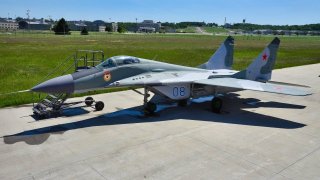How the U.S. Military Purchased 21 Russian-Made MiG-29 Fighters
Following the Soviet Union's collapse, the U.S. acquired 21 MiG-29s from Moldova in the 1990s to prevent Iran from obtaining them and to study the airframes.
Summary and Key Points: Since Russia's invasion of Ukraine in February 2022, attention has returned to Moscow’s airframes, notably the MiG-29 Fulcrum, respected for its capabilities.

-Developed during the Cold War, the MiG-29 features advanced weaponry and lightweight construction.
-Following the Soviet Union's collapse, the U.S. acquired 21 MiG-29s from Moldova in the 1990s to prevent Iran from obtaining them and to study the airframes.
-The Fulcrum remains a significant fighter, illustrating Soviet advancements in aviation technology.
MiG-29 Fulcrum: The Soviet-Era Fighter Still Making Waves
Since Russia launched its full-scale invasion of Ukraine back in February 2022, there has been a resurgence in interest surrounding Moscow’s airframe arsenal. From MiG-29s and MiG-31s to Su-35s and Su-57s, the Kremlin has deployed a range of aging airframes to the frontlines of the war. Much of Russia’s Soviet-era equipment being used in battle is less capable than the North Atlantic Treaty Organization (NATO-delivered).
However, one airframe developed by the USSR and still flown today that has garnered the respect of many aviation buffs is the MiG-29.
Considered one of the most capable Eastern Bloc fighters of the late Cold War period, the ‘Fulcrum’ is a highly respected jet.
Interestingly, the U.S. ended up with 21 MiG-29s in the mid-1990s, following the dissolution of the Soviet Union.
An overview of the MiG-29 Fulcrum
Following lessons learned in the Vietnam War, U.S. officials understood the need to produce an air superiority platform. Existing American airframes like the F-105 Thunderchief were considered subpar to the Soviet’s more advanced and maneuverable MiG fighters. To rectify this, U.S. engineers got to work to create the “F-X” program, which ultimately culminated in the introduction of the formidable F-15 Eagle.

The Soviets couldn’t let the U.S. gain air superiority without a fight and worked to create its own Eagle counter. By the end of this decade, the Soviet General Staff directed engineers to produce a fighter capable of reaching speeds over Mach-2.0 (times the speed of sound) with heavy armament abilities. Eventually, a workload split resulted in this effort and two programs emerged- the Su-27 and MiG-29.
MiG-29 Specs and Capabilities
The Su-27 was designed to carry out deep air-to-air missiles against NATO high-value assets, while the Fulcrum was crafted to replace the preceding MiG-23 fighter. When the Fulcrum embarked on its maiden flight in the late 1970s, its elevated capabilities became quite concerning to U.S. officials.
Essentially, it was becoming clear that the Soviets were catching up to America’s aircraft technology. The Fulcrum features seven external weapon hardpoints and can carry up to two R-27 air-to-air medium-range missiles, six R-73 and R-60 air-to-air short range missiles, four pods of unguided rockets and a vast array of munitions.
As detailed by Airforce Technology, “The R-27 medium-range air-to-air missile is supplied by the Vympel State Engineering Design Bureau, based in Moscow. The R-27 is available in two configurations: the R-27R, which has a semi-active radar homing head and inertial navigation control with a radio link and the R-27T missile, which is fitted with an infrared homing head. The missile can intercept targets with a speed of up to 3,500km/h at altitudes from 0.02-27km, and the maximum vertical separation between the aircraft and the target is 10km.”
In addition to its impressive armament, the MiG-29 was one of the first Soviet airframes to extensively use lightweight aluminum titanium alloys, which reduce overall weight and complexity. These fighters also achieved high-angle-of-attack capability due to their widely flared wing leading edge root extension. Countries around the world noted the impressive traits embodied by the MiG-29 and set out to acquire the fighter. Export models of the Fulcrum were sold to India, Iran, East Germany, Peru, Iraq, Poland, Sudan, Syria and others.
How the U.S. acquired MiG-29 Fulcrum fighters
When the Soviet Union collapsed, the U.S. had the opportunity to acquire the once-feared MiG-29 fighters. Over two decades, more than one thousand Fulcrums were produced in the USSR.
In fact, the peak annual production rate of single-seat aircraft was reached in the late 1980’s. Following the breakup of the country, huge swaths of military equipment- including airframes- were left outside Russia. The majority of these airframes were left in Ukraine, Kazakhstan and Belarus.

Concerned that such numerous nuclear-capable weapons were spread over multiple sovereign states, the Nunn-Lugar Cooperative Threat Reduction program was created in order to secure and dismantle weapons of mass destruction. By the late 1990s, the U.S. used funds from this program to purchase 21 nuclear-capable MiG-29 Fulcrum airframes from the Republic of Moldova- a former Eastern Bloc component.
Moldova indicated that the Islamic Republic of Iran was interested in acquiring these formidable fighters, which urged the U.S. to act swiftly. Ultimately, the U.S. paid $40 million in addition to providing humanitarian assistance in the Fulcrum transaction.
While preventing Iran from receiving modern MiG-29 variants was a leading factor in America’s decision to buy these fighters, the secondary reason was that U.S. engineers were able to closely examine an adversary’s airframe.
During the Cold War, the MiG-290 Fulcrum was feared as a competent platform. Dissecting such a significant aircraft was undoubtedly the cherry on top for U.S. officials.
About the Author: Maya Carlin
Maya Carlin, National Security Writer with The National Interest, is an analyst with the Center for Security Policy and a former Anna Sobol Levy Fellow at IDC Herzliya in Israel. She has by-lines in many publications, including The National Interest, Jerusalem Post, and Times of Israel. You can follow her on Twitter: @MayaCarlin. Email the Author: [email protected].
All images are Creative Commons or Shutterstock.
From the Vault
Russia Freaked Out: Why the U.S. Navy 'Unretired' the Iowa-Class Battleships
Battleship vs. Battlecruiser: Iowa-Class vs. Russia's Kirov-Class (Who Wins?)


